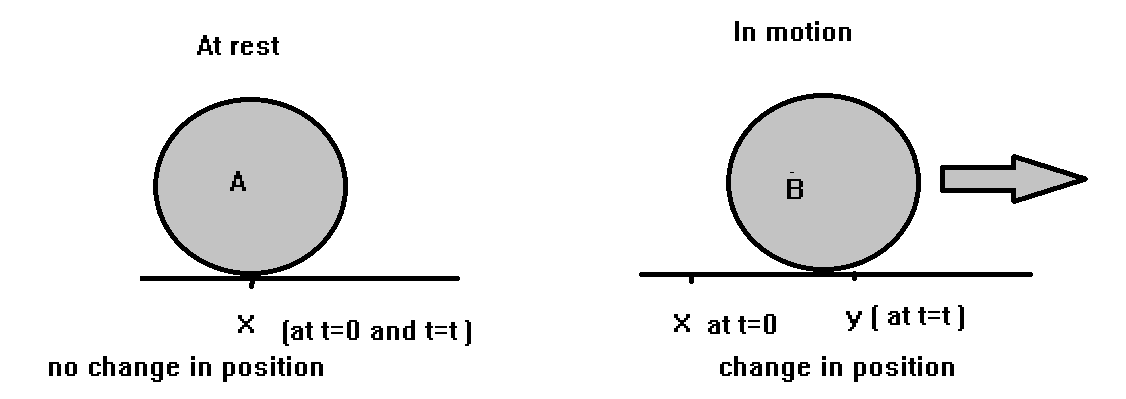
Define the state of rest and state of motion of an object.
Answer
554.7k+ views
Hint The state of rest and state of motion is a relative term as they depend on the frame of reference of the observer. The frame of reference decides whether the body is in motion or at rest. A body is said to be at rest when there is no change in its position while a body is said to be in motion it changes its position relative to the frame of reference.
Complete Step by step solution
We will understand this by an example. Let us consider there are two different observers $1$ and $2$, and the observer $1$ is moving means both of them are not at rest with each other than for the observer $2$ the observer $1$ will be in motion and vice versa. If there is no motion with respect to each other then for both of them they are at rest.

From the above figure we can see in the first image there is no change in the position $x$ of the body $A$ from time $t = 0$ to $t = t$ while in the second figure we can see that at $t = 0$ the body $B$ was at $x$ position while at $t = t$ the body $B$ was at $y$ position that means there is a change in its position at a time $t = t$. Hence body $A$ is said to be at a state of rest while body $B$ is said to be in the state of motion because its position is changing as it is moving.
Note There are four types of motion. They are named as linear, rotational, oscillatory, and reciprocating motion. Linear motion means motion in a straight line. Rotational motion is observed when the body makes a circular motion. Oscillatory motion occurs moves to and fro from its mean and fixed position. Reciprocating motion means the motion of up and down, two and fro in a straight line.
Complete Step by step solution
We will understand this by an example. Let us consider there are two different observers $1$ and $2$, and the observer $1$ is moving means both of them are not at rest with each other than for the observer $2$ the observer $1$ will be in motion and vice versa. If there is no motion with respect to each other then for both of them they are at rest.

From the above figure we can see in the first image there is no change in the position $x$ of the body $A$ from time $t = 0$ to $t = t$ while in the second figure we can see that at $t = 0$ the body $B$ was at $x$ position while at $t = t$ the body $B$ was at $y$ position that means there is a change in its position at a time $t = t$. Hence body $A$ is said to be at a state of rest while body $B$ is said to be in the state of motion because its position is changing as it is moving.
Note There are four types of motion. They are named as linear, rotational, oscillatory, and reciprocating motion. Linear motion means motion in a straight line. Rotational motion is observed when the body makes a circular motion. Oscillatory motion occurs moves to and fro from its mean and fixed position. Reciprocating motion means the motion of up and down, two and fro in a straight line.
Recently Updated Pages
Master Class 12 Economics: Engaging Questions & Answers for Success

Master Class 12 Maths: Engaging Questions & Answers for Success

Master Class 12 Biology: Engaging Questions & Answers for Success

Master Class 12 Physics: Engaging Questions & Answers for Success

Master Class 8 Maths: Engaging Questions & Answers for Success

Class 8 Question and Answer - Your Ultimate Solutions Guide

Trending doubts
What is meant by exothermic and endothermic reactions class 11 chemistry CBSE

Which animal has three hearts class 11 biology CBSE

10 examples of friction in our daily life

One Metric ton is equal to kg A 10000 B 1000 C 100 class 11 physics CBSE

1 Quintal is equal to a 110 kg b 10 kg c 100kg d 1000 class 11 physics CBSE

Difference Between Prokaryotic Cells and Eukaryotic Cells




